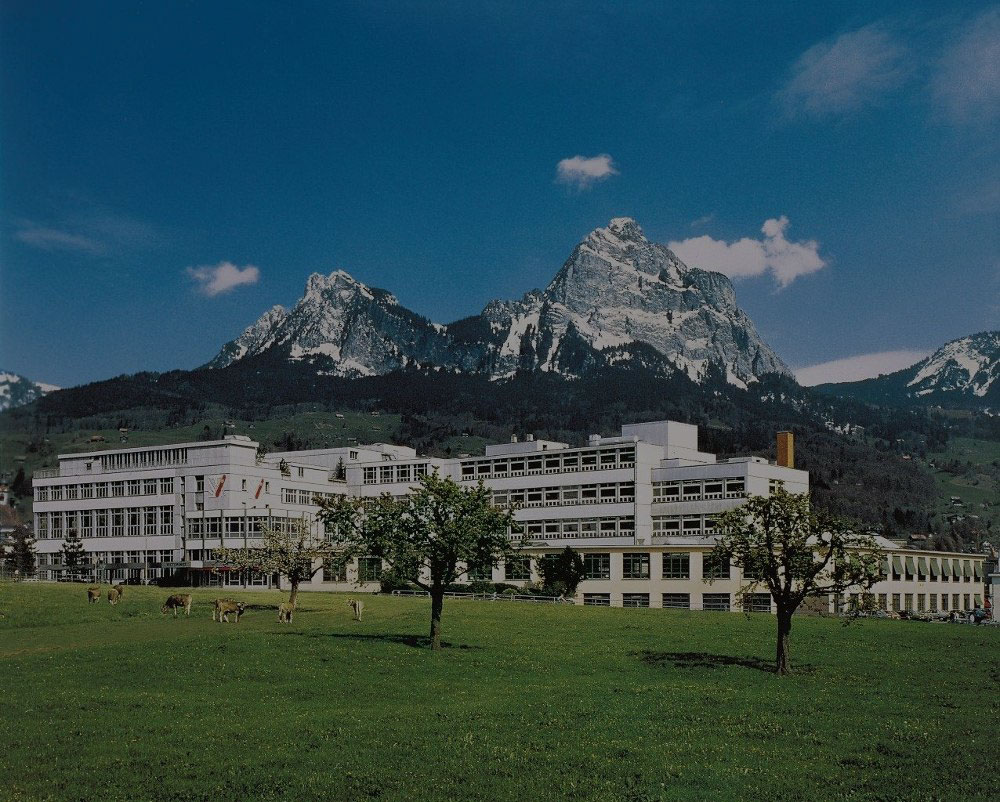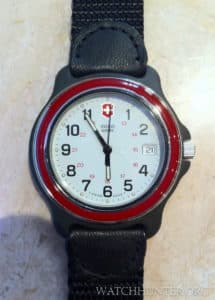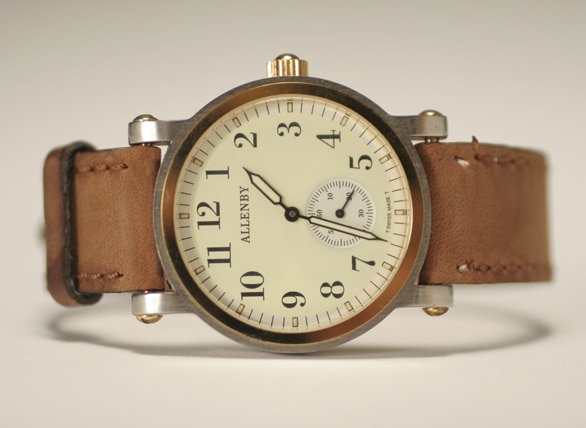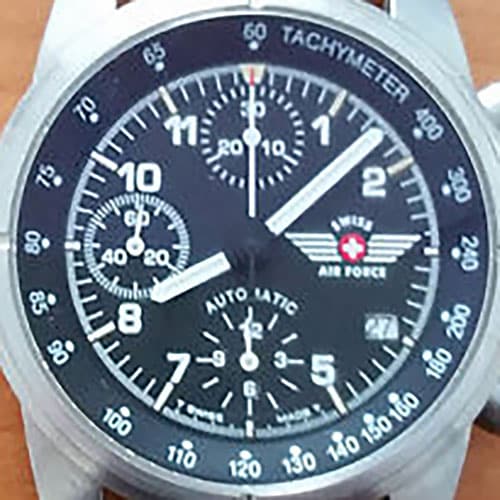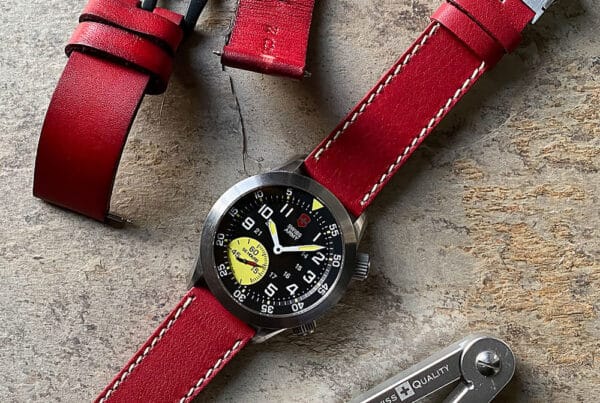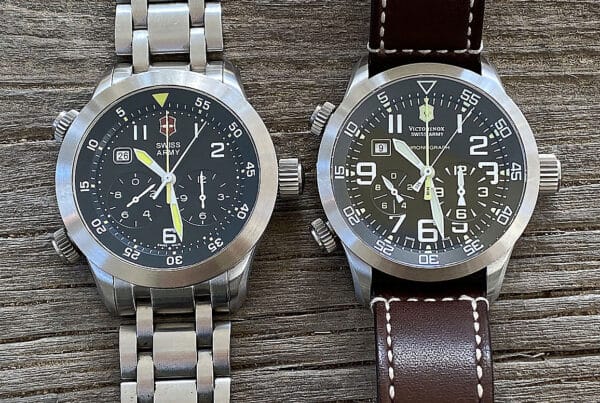 For years, I have daydreamed of writing the story of how Victorinox Swiss Army watches came to be. Detailed information is not easy to find and worse, it is difficult to verify. Most consumers do not really care about a watch brand’s internal power struggles. However, the origin story of Victorinox Swiss Army watches is interesting and worth hearing for collectors. There are twists and turns including the fact that Swiss Army watches were designed in America first by a brilliant graphic designer and a savvy product manager, but that is another story (or two) as they say.
For years, I have daydreamed of writing the story of how Victorinox Swiss Army watches came to be. Detailed information is not easy to find and worse, it is difficult to verify. Most consumers do not really care about a watch brand’s internal power struggles. However, the origin story of Victorinox Swiss Army watches is interesting and worth hearing for collectors. There are twists and turns including the fact that Swiss Army watches were designed in America first by a brilliant graphic designer and a savvy product manager, but that is another story (or two) as they say.
The history of Victorinox Swiss Army was going to be a tough one to tackle and frankly, I would not have been able to do it. I am not mentally equipped to unravel a corporate mystery like this. Heck, I can barely unravel my own family tree. Luckily, somebody else made my quest easier and wrote: “The Unofficial History of Victorinox Swiss Army Watches”. The author posted it on WatchUSeek on November 13, 2014, as a guide to other forum members. This is many years before I even considered writing it. You can see the original article on the WatchuSeek forum here.
The writer’s screen name is Neruda, and he is a retired university teacher in Chile. The information contained within the article is believed to be accurate. However, it is an unofficial history and not been vetted by any of the parties named in the account. Neruda has graciously granted permission to republish it here. So, without further hesitation, I present “The Unofficial History of Victorinox Swiss Army Watches” written from the perspective of 2014. This was the year that Victorinox Swiss Army celebrated their 25th Jubilee* so the brand’s backstory was on the minds of collectors. A very sincere THANK YOU! to Neruda for writing this Swiss Army watch history, and for letting me post it on my site.
Victorinox and the Swiss Army Brand
I recently bought a second-hand Swiss Army watch from the late 1990s and this got me wondering about its history. I posted my watch on another thread along with a bit of information I had discovered. Since then I have uncovered a load more information, largely relating to company history, and the story is considerably more complicated than the rather sanitized version given me by Victorinox. See the simplified timeline here where there are only a few mentions of the watches. If you are easily bored or prone to headaches, I suggest you skip this. On the other hand, in this forum and elsewhere, people have asked about vintage Swiss Army watches and in general, the answers are less than precise. Here then is what I’ve found.
First a quick MBA course:
1. If you make something, you don’t necessarily market it.
2. If you market something, you don’t necessarily make it.
3. Even if you own the brand, you don’t necessarily make the product.
4. If you are famous for one product, you may be able to use this reputation to sell other products.
5. If you market a famous product, you may be able to market associated products based on this reputation.
6. If you sell other products, first you have to get them produced.
Pen Knives
So let’s get started. In 1884, a certain Karl Elsener opened his own cutler’s business in Ibach-Schwyz in Switzerland. In the 1890s the Swiss army began to buy pocket knives to equip its soldiers – part of this government contract was won by Elsener. When Elsener’s mother, Victoria, died, he named the company after her. And in the early 1920s Victoria was combined with “inox” to stress that the knives were made from stainless steel. Karl Elsener never made watches, so if you have just bought a 1920s Victorinox watch on eBay, you’ve been royally had!
1921
Switch now to the United States. Charles Forschner & Sons was founded in 1855 in New Britain, Connecticut, as a manufacturer of butcher scales. After Forschner’s death in 1877 his son Richard changed the company name to RH Forschner and moved it to New York. The company began offering imported German cutlery to its butcher customers in 1921.
1937
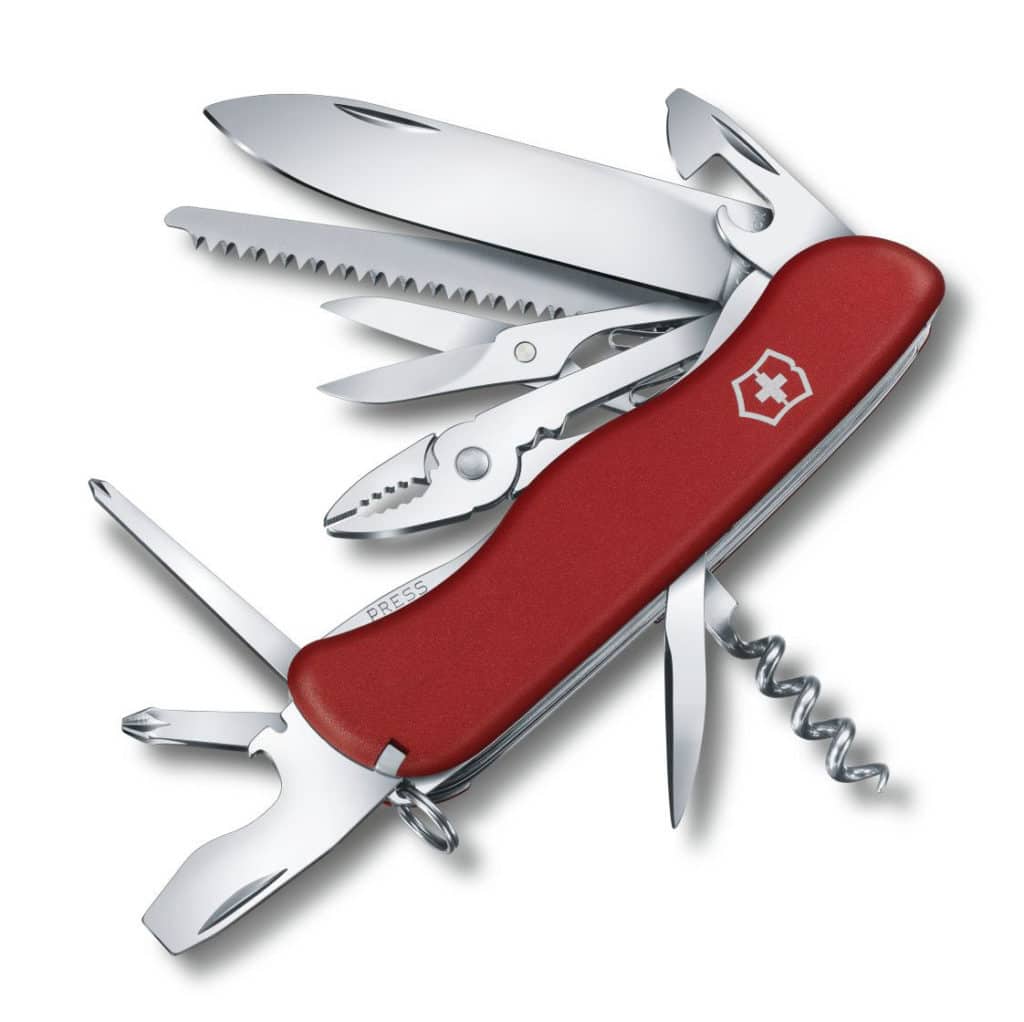 I suspect the Forschners were Jewish. Either way, the deteriorating political climate of Europe in the 1930s forced the company to seek alternative suppliers of their butcher’s knives. In 1937 RH Forschner began to buy knives from Victorinox.
I suspect the Forschners were Jewish. Either way, the deteriorating political climate of Europe in the 1930s forced the company to seek alternative suppliers of their butcher’s knives. In 1937 RH Forschner began to buy knives from Victorinox.
Then came the Second World War, and American soldiers began to discover the marvels of the Victorinox penknives supplied to the Swiss army. Rather than use the official Swiss German names, soldiers simply referred to them unofficially as “Swiss Army Knives”.
1972
After WWII ended, Forschner began importing these Victorinox penknives into the USA where they found a ready market. Soon Forschner became Victorinox’s biggest client. In 1972 the two companies signed an agreement giving Forschner exclusive rights to market Victorinox knives in the USA.
Still no watches, but we’re getting close!
Forschner ceased to be a family company in 1957. In 1974 investor Louis Marx bought the company and launched a policy of direct marketing to outlets such as Walmart and Target. Sales rose from $800,000 in 1974 to $11 million in 1981. Marx took RH Forschner public as the Forschner Group in 1983. The Brae Group, controlled by Marx, acquired 35.3% of the stock in the new company while Victorinox acquired 24.3%.
1989 – The Swiss Army Brands
 The new Forschner Group was intent on diversifying its distribution and marketing of Victorinox penknives which were popularly but unofficially known in the USA as “Swiss Army Knives”. It, therefore, asked the Swiss Defence Ministry if it objected to the use of the Swiss Army name to sell other Swiss-made products in the States. The ministry gave the green light, and Forschner had the name “Swiss Army Brands” registered as a trademark.
The new Forschner Group was intent on diversifying its distribution and marketing of Victorinox penknives which were popularly but unofficially known in the USA as “Swiss Army Knives”. It, therefore, asked the Swiss Defence Ministry if it objected to the use of the Swiss Army name to sell other Swiss-made products in the States. The ministry gave the green light, and Forschner had the name “Swiss Army Brands” registered as a trademark.
In fact, the Swiss Defence Ministry really had no control over the use of the term “Swiss Army” outside of Switzerland. However, as Forschner promised all goods marketed by the brand would be Swiss, the Ministry saw the initiative as a way to promote Swiss commerce and gave its endorsement royalty-free. Among the products which the Forschner Group selected for marketing under the new Swiss Army Brands were sunglasses, a compass, and, FINALLY, watches in 1989.
 The only problem was that neither Victorinox nor Forschner actually produced watches. The solution was to outsource production to a Swiss company, Xantia SA. Xantia SA had been founded in 1962 as a private label watchmaker, i.e. none of their watches were marketed under their own name. In 1989 Michel Thievent, a long-term employee of Xantia SA, acquired the share capital and management of the company.
The only problem was that neither Victorinox nor Forschner actually produced watches. The solution was to outsource production to a Swiss company, Xantia SA. Xantia SA had been founded in 1962 as a private label watchmaker, i.e. none of their watches were marketed under their own name. In 1989 Michel Thievent, a long-term employee of Xantia SA, acquired the share capital and management of the company.
1995
Forschner’s “Swiss Army Brands” marketing appears to have flourished. In 1995 Swiss Army Brands watches accounted for 43 percent of Forschner’s $126.7 million sales. J. Merrick (Rick) Taggart was elected company president in December 1995 and the following year Forschner Group shareholders agreed to change their name to the Swiss Army Brands Inc., or SABI, to more accurately reflect their principal line of business. Taggart’s background was in sports clothing and he had held senior management positions in companies such as Duofold, Marmot, Timberland, and Salomon.
Considering that SABI’s marketing angle was based on the strength of the Swiss Army penknife, SABI was faced with the dilemma of defining and protecting this foundation product. No trademarks existed specifically for “Swiss Army Penknife”, and many of the penknives made by Victorinox were never intended for use by the real Swiss Army. When SABI tried to prosecute an importer of Chinese copies of the distinctive red penknife, the US judge ruled that while a Swiss knife had to be made in Switzerland, a Swiss army knife was nothing more than a style of knife related to those used by the Swiss Army.
 A further complication was that Victorinox was not the only supplier of knives to the Swiss Army. Another company, Wenger, was also a contractor. By mutual agreement, Victorinox identified their knives as “original Swiss Army” and Wenger as “genuine Swiss Army”. At some point, Wenger entered the watchmaking scene as well, but that’s another story. And eventually, Victorinox took control of Wenger…
A further complication was that Victorinox was not the only supplier of knives to the Swiss Army. Another company, Wenger, was also a contractor. By mutual agreement, Victorinox identified their knives as “original Swiss Army” and Wenger as “genuine Swiss Army”. At some point, Wenger entered the watchmaking scene as well, but that’s another story. And eventually, Victorinox took control of Wenger…
1997
In April 1997 SABI introduced a line of 16 Swiss-made sports watches under the name Allenby and Co., Outfitters.
Launching the product, Mike Believeau, general manager, said in a press interview: “An Allenby Watch is one of the distinctive and indispensable accessories of the modern urban adventuring spirit. It’s the point where fantasy, fashion and Swiss precision craftsmanship meet. Rooted in turn-of-the-century imagery, as defined by the mythical FX Allenby, an explorer and adventuring spirit, the Allenby Watch Series in casual chic is designed to blend with the accelerating informality in our culture. It is intended to evoke a modern urban adventurer who can scale mountains, shoot rapids or travel the globe to discover a new world – whether that be in reality or in his or her mind.”
I don’t know how many awards for creative hype Believeau won, but it seems the Allenby line flopped and was discontinued shortly after its launch, maybe even after Believeau’s lunch!
1998
As if the Swiss Army wasn’t enough, SABI introduced the line of Swiss Air Force watches in 1998 to fill a high-end niche for automatics.
Of course, sooner or later it had to happen! The “Swiss Navy” watch is a cheap Chinese rip-off completely unconnected to either SABI or Victorinox. But yes, Switzerland does have a small navy!
Victorinox Versus Swiss Army Brands, Inc. (SABI)
It seems that initially, Victorinox had mixed feelings about Forschner using their reputation to launch the Swiss Army Brands (SABI). Certainly, Victorinox owned shares but not enough to dictate company policy. Perhaps at first Victorinox was concerned that diversification into new products would weaken the brand strength of their knives. Later, no doubt, as Swiss Army Brands succeeded and became highly profitable, Victorinox must have felt it had missed out! Yet whatever the misgivings, SABI was undeniably beneficial in promoting and increasing Victorinox knife sales. It seems then that the relationship between Switzerland and the USA was something of love and hate during the 1990s!
So, as SABI grew, Victorinox had four options: somehow combine with SABI, take control of SABI, take control of Xantia, or produce their own watches. In fact, it appears they did all four. In 2002 Victorinox became the sole shareholder of SABI, and in the presentation of their corporate image, all previous differences that may have existed have been neatly brushed under the carpet! This year, 2014, Victorinox is actually celebrating their 25th anniversary as a watchmaker – and this is creative, to say the least. Here, then, is an attempt to reconstruct what really happened.
According to one company analysis, Victorinox opened its own watch-making factory in 1999. This is unclear. What is certain, however, is the following.
In June 2000 SABI’s president Taggart announced an agreement to purchase the stock of Xantia, S.A. adding cryptically that Swiss Army might share its ownership in Xantia with another company but that no commitments had been made.
A month later all became clear when Swiss Army Brands, Inc. and Victorinox AG of Ibach, Switzerland, jointly announced the completion of the acquisition of Xantia, S.A. It appears that control of Xantia was to be held by SABI.
2000-2006
 In December 2000, Victorinox concluded a stock-purchase agreement to buy the 1.9 million shares in SABI held by Louis Marx’s Brae Group for $9.6 million. Along with the shares which Victorinox already held, this gave Victorinox control of SABI.
In December 2000, Victorinox concluded a stock-purchase agreement to buy the 1.9 million shares in SABI held by Louis Marx’s Brae Group for $9.6 million. Along with the shares which Victorinox already held, this gave Victorinox control of SABI.
Taggart resigned as president and CEO of SABI in 2001, although he would return.
Now that Victorinox effectively controlled the manufacture of Swiss Army watches by Xantia and the marketing of these watches by SABI, Victorinox was now in a position to determine the international future of its watch-making operation. The Swiss Army Brands continued in the United States, Canada, and the Carribean, but in July 2001 Victorinox and SABI announced the formation of a new company Victorinox Swiss Army Watch S.A. or VSA.
The new VSA commenced operations on 1 November 2001, headed by Susanne Rechner, formerly of Movado and Seiko. Cheri McKenzie, vice-president of global marketing for Swiss Army Brands, became responsible for marketing, while Jean-Marc Guillod, from Swiss Army Brands Schweiz and David Feuter, from Victorinox, directed international sales. Michel Thiévent and Michel Hofer of Xantia became responsible for the manufacture and development of Victorinox Swiss Army watches.
“Victorinox and Swiss Army Brands have a strong and long-standing relationship,” said Sue Rechner, president of the new company. “This merger is a natural combination of two watch brands with similar attributes and complementary business strategies. All of the individual strengths of the two watch brands will be combined to form a strong company poised for international growth.”
Victorinox continued to acquire shares in SABI. As of June 2002, Victorinox owned 5,262,400 shares of common stock in the company while Charles Elsner Sr. privately owned a further 5,609,105 shares, giving Victorinox approximately 66.9% control over SABI. Victorinox pushed to buy up the remaining shares and despite a lawsuit, successfully acquired 100% ownership of SABI by the end of the year. Susanne Rechner was promoted to become the new CEO of SABI.
In 2006 Victorinox lost control of Xantia SA, their watch-making factory, following a management buyout which left Jean-Pierre Loetscher as the new CEO. This forced Victorinox to relocate their watch factory to Porrentruy in the Swiss canton of Jura (see factory photo at the end).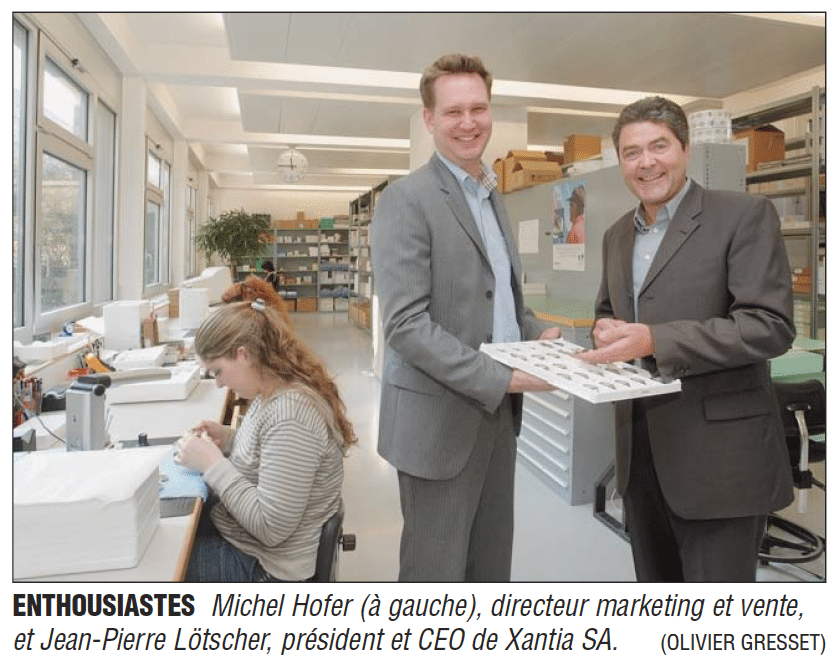
2007-2008
Between 2007 and 2008 Victorinox standardized its North American and International markets. SABI, it seems, changed the name to become Victorinox Swiss Army Inc. in the US. Susanne Rechner resigned and J. Merrick “Rick” Taggart returned once more to become president of the North American subsidiary.
Well, this more or less brings my history of Victorinox and Swiss Army up to date. In conclusion, if you have a watch marked “Swiss Army” manufactured before 2000, it was made by Xantia for the Swiss Army Brand Inc., a company partly owned by Victorinox but not controlled by them. For my money, Victorinox really didn’t get directly involved in the watch business until around 2000 – so whether they are, as they claim, a watchmaker with a 25-year history is rather a question of interpretation. If you’ve had the patience to read all this, I would greatly value any comments and corrections!
2009-present
This more history is not yet written, but the major shifts for Victorinox Swiss Army seem to have settled down. The company seems to be consolidated and in control of making its own watches.
Other References:
- Originally post on WatchuSeek Forum: https://forums.watchuseek.com/f2/victorinox-swiss-army-brand-1224114.html
- Wikipedia: https://en.wikipedia.org/wiki/Victorinox
- Reference for Business: https://www.referenceforbusiness.com/history/Ul-Vi/Victorinox-AG.html
Disclaimer
As much as I tried to find photos of all of the major executives, it was nearly impossible. I inserted people that I could find. If there are errors in this loose history, please contact me so I can update the timeline. This timeline contains a general overview of the company, but not every detail.
*2014 was celebrated as Swiss Army watches 25th Anniversary jubilee because they started making watches in 1989. However, some of the limited edition watches had the phrase “125 years” on their boxes and engraved on the watch case. Somewhere the math does not work out. Whatever the case is, check out the article on the rare Swiss Army Infantry Vintage Jubilee Edition.

